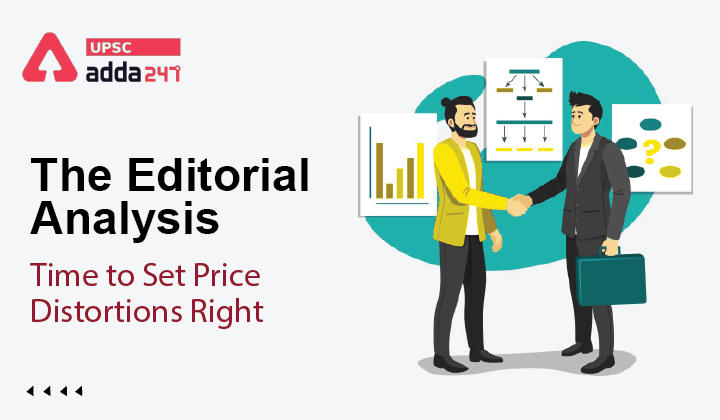Table of Contents
Time to Set Price Distortions Right- Relevance for UPSC Exam
- GS Paper 3: Indian Economy– Issues relating to planning, mobilization of resources, growth, development and employment.
From Ease of Doing Business to Reducing Cost of Business
- The recent hike in Petrol, Diesel and Gas prices is resulting in a rise in the cost of doing business in the country. This is further compromising the ease of doing business in India.

Economic Reforms and Ease of Doing Business
- One of the key objectives of reforms has been to reduce the distortions generated by the earlier excessive micromanagement of the economy.
- With internal economic liberalisation and openness to international trade and investment, an open free market economy has emerged.
- Improving the ease of doing business continues to be a major priority. But even more important is the cost of doing business.
Ease of Doing Business (EoDB) for Aatmanirbhar Bharat- Five Structural Reforms for EoDB
Issues with Cost of Doing Business in India
- Government Policy Induced Price Distortions: pricing distortions have become a source of competitive disadvantage to domestic value addition and job creation.
- India’s relative lack of success in manufacturing and employment generation is the outcome.
- Origin of government policy-induced pricing distortions: It lies in the political need to-
- Find a way out for a cash-strapped government to raise resources.
- Provide affordable goods and services to those in need through a cross-subsidy within the sector without having to find the money for direct subsidy payments.
The End of the Ease of Doing Business Rankings
Price Distortion in Electricity
- Electricity pricing is also highly distorted.
- A cess of ₹400 per tonne on coal was levied to generate resources for the promotion of renewable energy and decarbonisation of the economy.
- When GST was introduced, the receipts from this cess were suddenly diverted for making good the shortfall in tax receipts of the States.
- The present consumption of about a billion tonnes of coal generates revenue of around ₹40,000 crore.
- About two-thirds of this additional cost is borne by the electricity sector.
National Conference on Cooperation Policy
Impact of Price Distortion in the Electricity Sector
- As the Railways have been unable to raise passenger fares to cover their costs, they need to cross-subsidise passenger traffic from goods freight.
- They, therefore, charge about twice the actual cost for carrying coal to thermal power plants.
- This distortion adds to the cost of coal for thermal power plants and further increases the price of electricity for the distribution companies.
- They, in turn, cross-subsidise most domestic household consumption by having higher tariffs for industrial users.
- This increases the cost of industrial production vis-a-vis competitors in other countries.
- The consequential loss of competitiveness results in lower manufacturing growth and the creation of fewer jobs.
Price Distortions in Energy fuels like Petrol, Diesel
- Energy is the basic requirement of the modern industrial economy and the key to competitiveness.
- Its pricing distortions are onerous. In the early days, cars were considered luxury goods and high excise duty was levied on petrol, but it was lower on diesel to make it cheaper for the essential needs of transport.
- The price difference between petrol and diesel led to a surge in the supply and use of diesel cars and SUVs.
- This distortion led the government to increase the price of diesel gradually. The price difference has since been marginal.
- Reason for Price Distortion: Exceptionally large revenues that came to the government from the high taxes on petrol and diesel created such a dependency that these have been kept out of GST.
- More recently, the central government has been raising taxes on these to raise additional revenues to moderate the fiscal impact of COVID.
- Impact of Price rise of Energy: This has given an inflationary impetus.
- The real adverse impact is on the cost of road transport of goods which makes the cost of logistics about twice that of our competitors.
Ensuring Low Cost of Doing Business- Way Forward
- Reducing Policy Induced Price Distortion: Action is needed to reduce government policy-induced pricing distortions which add to the cost of doing business.
- Political Will: Reducing cost of doing business would need leadership and investment of political capital in generating a consensus and steering change.
- Bringing GST under GST Regine: Petrol and diesel, therefore, need to come under GST. Even at the highest rate of 28%, the price of petrol would be around ₹60 per litre.
- The discussion needs to be on how to manage government finances thereafter.
- Streamlining the Land Acquisition Process: Land use conversion and redevelopment processes need to be made user friendly.
- Combined with public provision and up-gradation of quality infrastructure this would reduce supply-side constraints and lower prices in real terms.
Promoting Private Investment- Way Forward
- Only private investments can create jobs for our young generation. Government jobs are a mirage.
- The sooner we realise this and start grappling with feasible pathways for reducing the cost of doing business and getting a surge in private investment which creates jobs, the better.
The End of the Ease of Doing Business Rankings




 TSPSC Group 1 Question Paper 2024, Downl...
TSPSC Group 1 Question Paper 2024, Downl...
 TSPSC Group 1 Answer key 2024 Out, Downl...
TSPSC Group 1 Answer key 2024 Out, Downl...
 UPSC Prelims 2024 Question Paper, Downlo...
UPSC Prelims 2024 Question Paper, Downlo...
